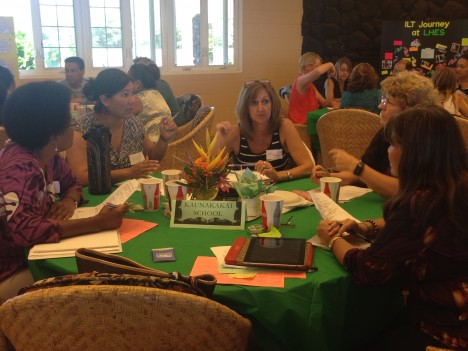Empowering Teachers for Student Achievement
Celebrating student success and showcasing school achievement were hot topics at the first-ever Canoe Complex Summit last Monday.
Dozens of teachers and administrators in the complex area for Molokai, Lanai, Lahaina and Hana schools, the so-called “Canoe District” of Maui County, shared their journey and challenges faced during the academic year with other educators.
Instructional Leadership Teams (ILTs) from Molokai and Lanai schools met to discuss approaches on readying students for college and thriving careers. Each ILT — a team of educators that collaborate to target academic areas of weakness within their school — shared their trials and successes with teams from other schools at the Molokai Community Health Center.
Lindsay Ball, Maui County complex area superintendent, stressed the importance of relationship building within each ILT. By sharing diverse stories with other schools in the complex, the summit creates a support system for teachers, Ball said.
“It’s important we make connections on our own campus and in our school communities,” Ball said. “It’s important and it’s critical that you have a say and work collaboratively with everyone else in you staff. That’s necessary to do what’s best for the kids.”
Alison Place, Molokai and Lanai Complex School Renewal Specialist, said it’s just as much about educators as the students.
“This summit is about teacher empowerment and building teacher leadership to drive work towards student success,” she said.
Each year, ILTs from schools across the state hold a summit to showcase the work they have accomplished in their complex or complex area. For the first time, teams from Kilohana, Kaunakakai and Maunaloa elementary schools, as well as Kualapu`u School, Lanai High and Elementary School, Molokai High School (MHS) and Molokai Middle School (MMS) held their own Canoe Complex Summit. While MHS and MMS teachers attended, they won’t start ILTs at their campuses until next year.
“We’re working towards student success,” Place said. “It’s about powerful instructional practices in a targeted area. It’s also about staff success, because we know that in order for us to deliver success to our students we need to have staff training, support and feedback for our teachers.”
During the summit, ILT schools shared their work and feedback with participants in a rotation activity. Attendees had the opportunity to walk by every school’s display to identify challenges and possible solutions.
Kilohana Elementary School’s ILT collaborated to examine data and determined informative writing needed to be addressed for students. Sixth grade teacher Lisa Palmer said she advised fellow attendees to welcome mistakes in implementing the ILT and working together.
“Know that there is no one way to do this…just trust the process and get through it,” Palmer said. “[Kilohana] is going slow to go fast, and it’s working out for us. We’re giving ourselves time to make mistakes and find the right materials and resources necessary to move forward and help our students.”
At Maunaloa Elementary School, Teddy Sotelo, a second grade teacher, said collaboration with ILT members is necessary to achieve goals and student success. His presentation addressed how the Maunaloa ILT targeted opinion and argumentative writing and reading comprehension.
Kamalu Poepoe, Hawaiian Language Immersion Curriculum Coordinator at Kualapu`u School, said her school’s ILT focused on writing and citing evidence. During the school year, Kualapu`u adjusted reading schedules to accommodate more writing time in homeroom.
“We wanted students to know citing evidence is for every class and to use the language frame for more sophisticated tasks,” Poepoe said. “…We developed ILTs for every grade level and found our colleagues learned to establish meeting times to collaborate.”
Each school’s ILT was created in collaboration with Targeted Leadership Consulting (TLC) at the start of the 2013-2014 school year. The TLC is a Department of Education program that assists schools nationwide with developing ILTs to improve student academic achievement. By the third year of the TLC program, each school’s ILT will be able to operate on its own and self-sustain the systems put in place to improve student learning.
“Empowering teachers in this way has had an incredibly positive impact on each school’s improvements efforts,” Place said.












Don't have a Molokai Dispatch ID?
Sign up is easy. Sign up now
You must login to post a comment.
Lost Password